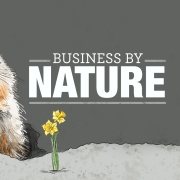5 Things Mockingbirds Can Teach Us About Branding
If nature’s vocal virtuosos can sing their way to market success… so can your brand!
Part of the “Business by Nature” Series. Nature is our planet’s original economic system. Plants and animals compete for resources every day, finding clever, innovative ways to stay successful… all while maintaining our planet’s delicate ecological balance. So, we joined forces with award-winning environmental scientist, Dr. Cindy Smith, to find “entrepreneurial inspiration” in nature, with an eye for sustainability and corporate responsibility.
In early-late winter, northern mockingbirds—aptly named Mimus polyglottos, or the many-tongued mimic—can be heard “defining their space” in backyards and urban areas across North America. A male mockingbird’s song boldly stakes his claim over his territory and advertises to potential mates that he’s got “somethin’ worth buyin.’” If you catch my drift.
If you’re a marketer, you might be thinking, “You know what? That kinda sounds like what I do for a living!” And you wouldn’t be wrong—because, in a way, mockingbirds are nature’s original branding experts. Just as a brand carves out its economic niche with a strong, well-defined message, a mockingbird carves out its ecological niche with a similarly unique point of distinction: a song.
So, here are a few notes of wisdom (pun intended!) that we, as marketers, can take from these feathered brand gurus…
1. Find your position.
For a male mockingbird intent on cornering the market, his first order of business is finding a resource-rich territory that’s compelling to a potential mate—in essence, his “customer.” He will strategically position himself on high points around his territory, actively advertising his presence to females and competitors. Once he’s found a mate, he continues belting out ballads from these strategic perches, dissuading competitors from encroaching on his territory.
Just as mockingbirds strategically define their “area of influence,” a brand must find a position (e.g., an angle, a promise, a benefit) in a given market that is both distinctive from competitors and compelling to potential consumers.
2. Find inspiration wherever you can.
As the season progresses, mockingbirds greatly expand their complex repertoire of melodies by mimicking snippets of songs from other bird species, as well as sirens, car locks, dogs and even treefrogs. Not only does this impress potential custome… ahem, mates… it also helps to signal their presence more strongly to competitors.
Mockingbirds are not only expert singers—they’re expert listeners. They pay close attention to what’s happening in their market and then repurpose compelling ideas in unique ways to make them ownable and differentiating.
3. Tell a rich, dynamic story.
Mockingbird songs expand in complexity, building, morphing and, in essence, telling a story in sound—a story that uniquely identifies them as owners of a particular ecological niche. The more experienced mockingbird songsters exhibit greater vocal complexity, making it easier to tell a story that attracts a mate and establishes a territory suitable for raising a few families (clutches). Certainly, creativity and experience count.
Much the same as mockingbirds, brands must cultivate a position-defining narrative that fosters empathy, interest and excitement among their customers/consumers. An effective brand narrative has to feel—and sound—rich and compelling.
4. Adapt to your market.
As conditions cool during fall and winter, mockingbirds shift their summer diet from insects, spiders and earthworms to wild berries and fruits. They know how to adapt to seasonal changes, shifting their approach to utilizing resources. And, of course, both males and females continue to change their tune (literally) as their “market” evolves.
Similarly, brands must track the “temperature” of a given market and shift into new campaigns, messages and product lines as necessary. A successful mockingbird—just like a successful brand—must be more than a “one season wonder.”
5. Don’t lose sight of your original “song.”
Even as mockingbirds continue to evolve the complexity of their songs, the defining elements that set their tune apart from those of other birds remain. They strike a balance between expanding their “brands” (in essence, adding sub brands and new product lines), while retaining the key melodic elements that are distinctively mockingbird.
At the core of every successful brand, despite changing market conditions and shifting consumer trends, lies a core promise. Something that’s foundational. Something that must always stand. Something that should remind consumers, customers and competitors that your brand is yours.
Interested in more insightful parallels about ecology and economy? Stay tuned for the next “eco collab” from Dr. Cindy Smith and Matt Donahue.
Dr. Cindy Smith, PhD, is an award-winning educator, environmental scientist, adventure wizard and corporate sustainability consultant. As an Environmental Science and Policy professor at George Mason University, Dr. Smith has dedicated her career to making knotty ecological problems easier to understand for the public, K12 and corporate audiences. IG @cindywahoo drcindysmith.com
Matt Donahue is a Creative Director at Seed Strategy with a passion—and a penchant—for product innovation, marketing theory, brand strategy, clutch alliteration and well-timed em dashes. Not to mention the occasional fragment. Matt is a graduate of Seton Hill University’s “Writing Popular Fiction” master’s program and writes whenever he can.
Connect with us! Follow Seed Strategy on LinkedIn, Twitter, Facebook and Instagram.









Trackbacks & Pingbacks
[…] in more insightful parallels about ecology and economy? Check out 5 Things Mockingbirds Can Teach Us About Branding, Why Cicadas Are Nature’s Most Industrious Innovators and Weathering Hard Times, Hog Style—and […]
Comments are closed.